Old Norse, New Tricks
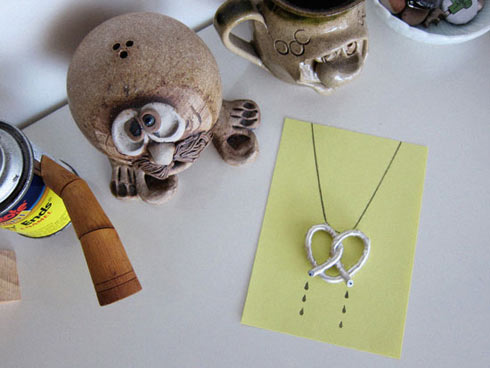
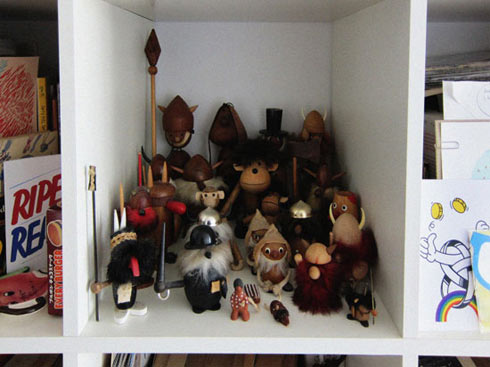
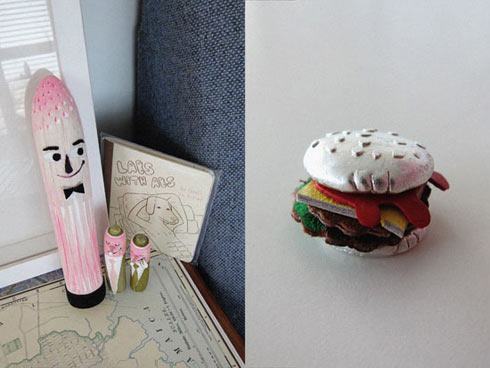
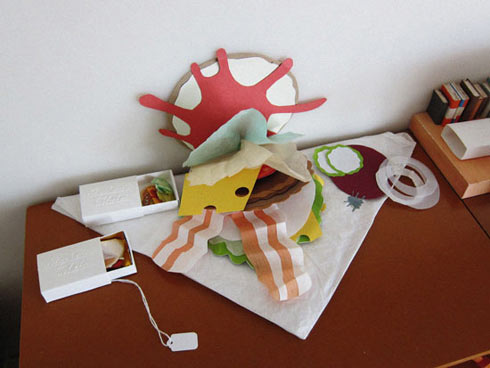
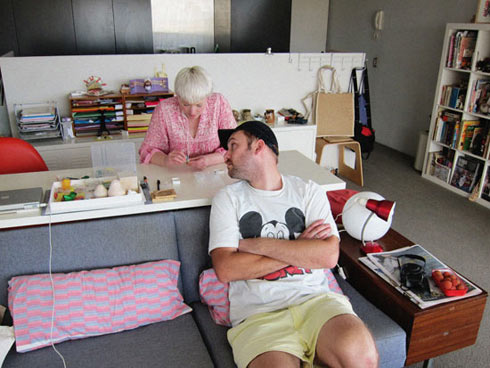
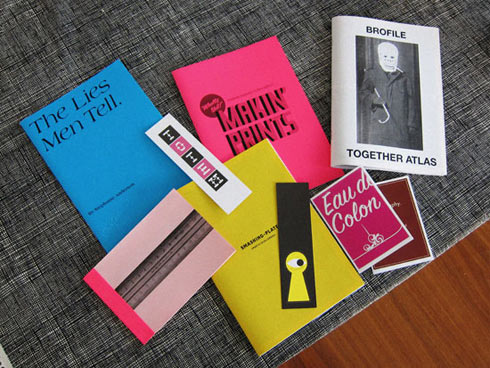
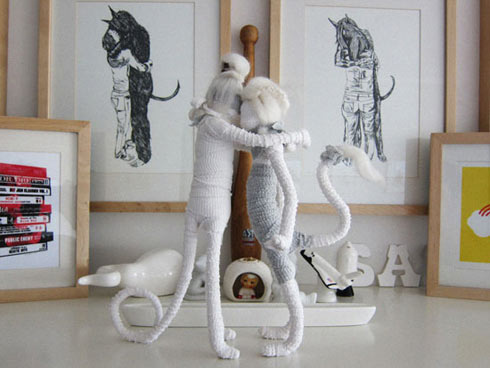
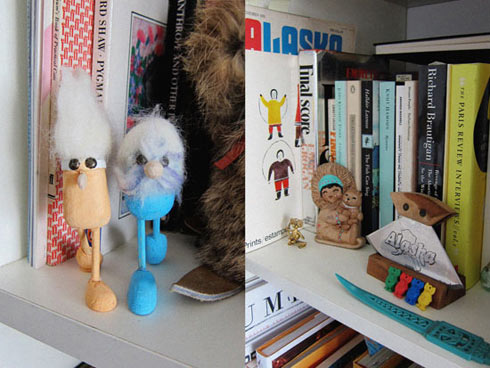
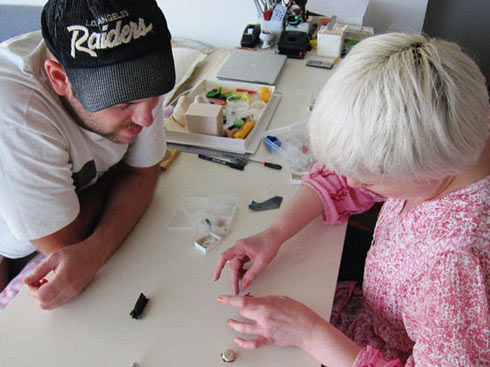 Text & Images: Tristan Ceddia
Text & Images: Tristan Ceddia
Standing taller than most and occasionally dressing like nordic tourists from the late 70s, Dave Ladd and Stephanie Anderson create a boot load of interesting stuff. He is big into sign writing and publishing zines whilst she is a model maker and animator, and together they had a modest studio named He She It They I. Rumour has it they once stretched a tin can phone between their apartment and that of a friend, as a very temporary mode of communication. There have also been whispers they hid a weed plant in an exhibition they had last year. Tristan Ceddia visited Dave and Steph in their Kings Cross apartment to talk about what other worldly things they have brewing.
Tristan Ceddia: So tell us a bit about yourselves? What are your backgrounds?
Dave Ladd: I studied illustration, practiced graphic design and worked in film and branding in the UK. Most recently I’ve been working in advertising. All via graffiti, collecting, building and sawdust-creating. I come from a family of makers and I guess that’s what I want to do.
Stephanie Anderson: I grew up in country NSW, public schools, all pretty normal I thought. I had great parents that I didn’t appreciate at the time, and a brother who was way too good at everything. We watched a lot of Muppets and Monty Python.
My family were also makers, but quite dissimilar to Dave’s, who are really proper craftspeople. My fam were more make-shift. My mum made us a lot of awesome things from MDF, like a two storey dollshouse with a lift, and she has encouraged every single thing I’ve believed in, especially Dave. Awww…
As well as making ferris-wheels for birds out of painted tin cans, my dad self-tinted the windows on at least one of our vans – using what I’m sure was just ordinary school-book contact. He also designed and made a prototype of a cruelty-free mousetrap on my request. I wish I could go back and appreciate all that now. Education wise, I’ve studied Communications, and also Fine Arts at COFA, did a year of Fashion too, and somehow managed not to obtain a degree.
TC: Steph, you work a lot with model making and stop animation. Are you formally trained as an animator or is this something you have taught yourself? Do you work commercially in animation?
SA: Um, I don’t know if I’d say I’m formally trained exactly. And I’d be kidding myself to say I am an animator. It’s such an incredible craft and skill.
When I was at COFA, animation was part of our time-based art course, and it was what I really loved. So we learned a lot about animation, were shown lots of amazing works I’d never have seen otherwise, and we were encouraged to have a crack at making animation using any means available, but it WAS art school after all, it was about the concept more than mastering the craft.
In my first or second year there, I found a roll of 16mm film print in a skip and took it home and scratched into some frames, no doubt just after having been shown the work of Paul Winkler or Len Lye. I then spent hours and hours, longer than I’d ever spent making anything, and had no idea what it would look like. But when I saw it projected, it was nearly 30 seconds for me, of absolute joy.
I’ve only really recently come to realise that same joy in making three dimensional objects, creatures, characters. I mean, tangible 3D, not digital. It’s that same expectant anticipation, waiting to see something cast in silver, or fired porcelain.
TC: I know collectively and independently, you both do a lot of creating, what is He She It They I all about?
SA: I love it when Dave tells stories, whether it’s about his mum and sister, or a news story or a childhood tale of he and a best mate, the characters featured are always ‘Your Mate’, ‘Chopsy’, ‘Knackers’ or the like, and he has a great way of just swapping out the gender unintentionally: “So Knackers is showing me his car, and she says-” “She?” “No He, Your Mate”.
DL: Don’t listen to Steph, she’s easily confused.
SA: He really is…
DL: He She It They I. is the everyman. I don’t mean the Aussie Battler, just that what we make is accessible. It’s not intentionally Low-Brow, Kustom or any one specific thing. We want everyone to be involved and they can. Dick jokes included.
TC: You have recently put the HSITI blog into drive and I know Dave, you been working on some new zine projects of late, what else do you have in the pipeline?
DL: Zine-wise we have a group zine called TOTEM that I want out by the end of February. Full of rad usual-collaborators plus a few new and exciting faces. We’re def def definitely working on something by the incredible We Buy Your KIds, and Matt Sewell and I have been threatening to make something together. Steph’s bro Otto is putting together what up until now has been a technical question mark, but we reckon we’ve resolved it. So yeah – that too.
We’re in the process of launching a small range of hand-made and cast silver jewellery (a sneak preview of which you’ve shown here). Stephanie’s leading the charge on that – I’m just fannying about, learning from her.
The blog is a work in progress too. It’s as much about our friends and those we admire, as us, but it all relates pretty much to exactly what we’re doing at that moment.
TC: Steph, you have gained a notoriety from your hamburger zines. I heard they were picked to be featured in a book recently?
SA: Hehehe. It was a funny turn of events spanning two annual MCA zine fairs, and it’s fun that it’s still playing out. I had my first attempt at making a zine for Dave to take to the Fair in 2008. I didn’t really take it seriously. I was a bit disrespectful of the zine culture to be honest.
Our house was full of coloured card and paper left over from recent jobs. I stapled together an arbitrary bunch of different colours and textures, cut some out in shapes and put a hole punch through it, and that was it, my zine. Then I went, oh that looks kinda like cheese, and that looks like a tomato sauce splat… and then I sat up the rest of the night with Dave and our friend Benzo, checking the massive pile of paper for ingredients (lettuce – green tissue paper; bacon – translucent textured salmon card) – and made my burger. It was so lovely when the amazing Sonny and Biddy ended up buying it. Wow.
Following year I made mini-sized ones. Put a little more effort into them, and it’s these which (I hope) will be featured in a book sometime this year, yes! Very flattering and exciting.
And following on from that, I’m making some jewellery, pendants. Burgers and some other bits too, sandwiches, cheese on toast, pears. All food related I just realised. Jeez.
TC: Your show Making Friends last year at China Heights gallery brought together a fun/pun mix of graphic design, model making, art, typography and plant life. Did the show come together and play out as expected?
SA: Looking back at early sketches I was surprised to see that some things actually did make it in, but I don’t think we really set out to create a specific thing. We’re probably both too scared of failure, or too lazy to work towards a goal in that way.
But it was amazing, the whole experience, and in that sense it wasn’t at all what I expected. I didn’t expect to enjoy the process, or the opening night, or to come out of it feeling so inspired that I carried armature wire around everywhere with me for the next couple months, just in case I wanted to make something.
We also had the very horrible experience of losing a wonderful and close friend of ours just before the exhibition. We were glibly dealing with notions of friendship and love and death, and then suddenly the plants growing or dying in the corner of the room had enough gravity to make me cry. Mark and Ed (of China Heights) were awesome, they were never stressed, or never showed it, not even with me crouching all day in the corner with those plants.
DL: It started as something and end up another thing. Some things surprisingly remained, but I don’t think we would have ever made what we originally discussed. It was an incredibly organic process and again, surprisingly without hiccups, too much stress or arguments. Fuck knows what we did right. Or wrong.
Like Steph said, Mark and Ed were a great barometer and sounding-post, working with us to make it happen smoothly and on-time, but also to have fun doing so.
Making Friends was an exact mirror of our relationship and mindset at the time: Friendship; loss; collaboration; celebration and ultimately, growth.
TC: Your works reference an eclectic mix of vintage style design, illustration and animation. Do you feel you represent these themes in the design process also?
SA: Interesting question actually, and I don’t even know if you are addressing me at all here, but it has made me think, in some instances it seems the processes we’d use are so far removed from traditional methods, I mean, digital cameras, scanners, retouching programs. But I’m reminded by the multiple cuts and grossnesses on my hands that we’re frequently hand carving, cutting, sanding, polishing – so i don’t feel like we’re very tech savvy or tech heavy.
DL: Um, I guess none of the crafts we use are new. Gocco, Riso, drawing, sculpting and casting. Even the animation is as basic as animation can be without being a flip-book.
We don’t have a great deal of room to work or abundant resource and I guess this dictates what we make: If there was a kiln accessible and nearby, Steph would make more porcelain. Steph really drives the different things we make and I usually tail-in on whatever materials she’s using – until I lose interest. I’m happy doodling and stapling and trimming.
Lo-fi processes usually produce lovely results – like seeing the maker in the made. I adore and reject modernism in equal parts, although I wish I could design like the current modernist designers in the UK. I can’t, but I can look at their work for hours on the internet and put it folders by hand.
TC: Dave I know you are heavily into hand done sign writing and truck pin-striping. What is the attraction here?
DL: Truck pinstriping is, to me, part of our national identity. The scrollwork, colour-ways and dedications are all done in a uniquely Australian hand. Traveling to visit our grandparents as kids, we’d drive up Cement Hill (in Brighton, South Australia) and there’d be a procession of semis alongside us. I distinctly recall asking my parents what function these scrolls had. I couldn’t believe they could be simply decorative.
I barely notice the trucks themselves and – besides the craft – don’t particularly like the aesthetic tone of US-style striping. Australian trucks and their scrolls are a beautiful masculine/feminine dichotomy.
Signwriting, like pinstriping, is a living thing. Never perfect, the artist’s hand is present and the type-forms make so much more sense in an environment built for humans. Signwriting allows the corner deli to have it’s own voice, it’s own character and it’s own identity. We called our corner-shop the Green Frog Deli ’cause it had a green frog painted on the hoarding. So rad.
Signwriting isn’t two weights of Helvetica or copy/paste design. No matter how old, faded or poorly painted, it’s intrinsically live communication.
TC: You both collect vintage souvenirs from around the world. From what I gather, there is an underlying Nordic and Alaskan theme here. From what comes your obsession with the northern regions of the globe?
SA: My dad was Canadian, with a Finnish mother. He was in the Airforce, so had spent time travelling about before moving to Australia. He used to have lots of funny little Viking/Eskimo/Gonk figures that I coveted. But he was also averse to snow, vowed never to see it again, and didn’t up to the day he died (from melanoma!). Hence when I met Dave I had never seen snow, and I was as averse to sun and heat as my father to snow.
I knew Dave a little when he came to Berlin where I was living, for his work with the Edinburgh Film Festival. Their next stop was Oslo and he convinced me to come along to see snow. Which I did. And did. That whole experience certainly cemented the Nordic thing.
There is also the Velvet Underground song Stephanie Says, and the fact that Dave used to write Alas, as good pointers toward Alaska.
DL: The pattern, form and colour used in Nordic and Scandinavian design is incredible. It is linked to a tradition of hand-craftiness and is immediately recognisable as such. Nah, it’s just rad in the North.
TC: What does the future hold?
SA: Making the most of our current situation and the fact that we are both inspired. Just wanna make, make, make at the moment – while that moment lasts.
DL: North to the future!
He She It They I
Next story: Max Health – Health



